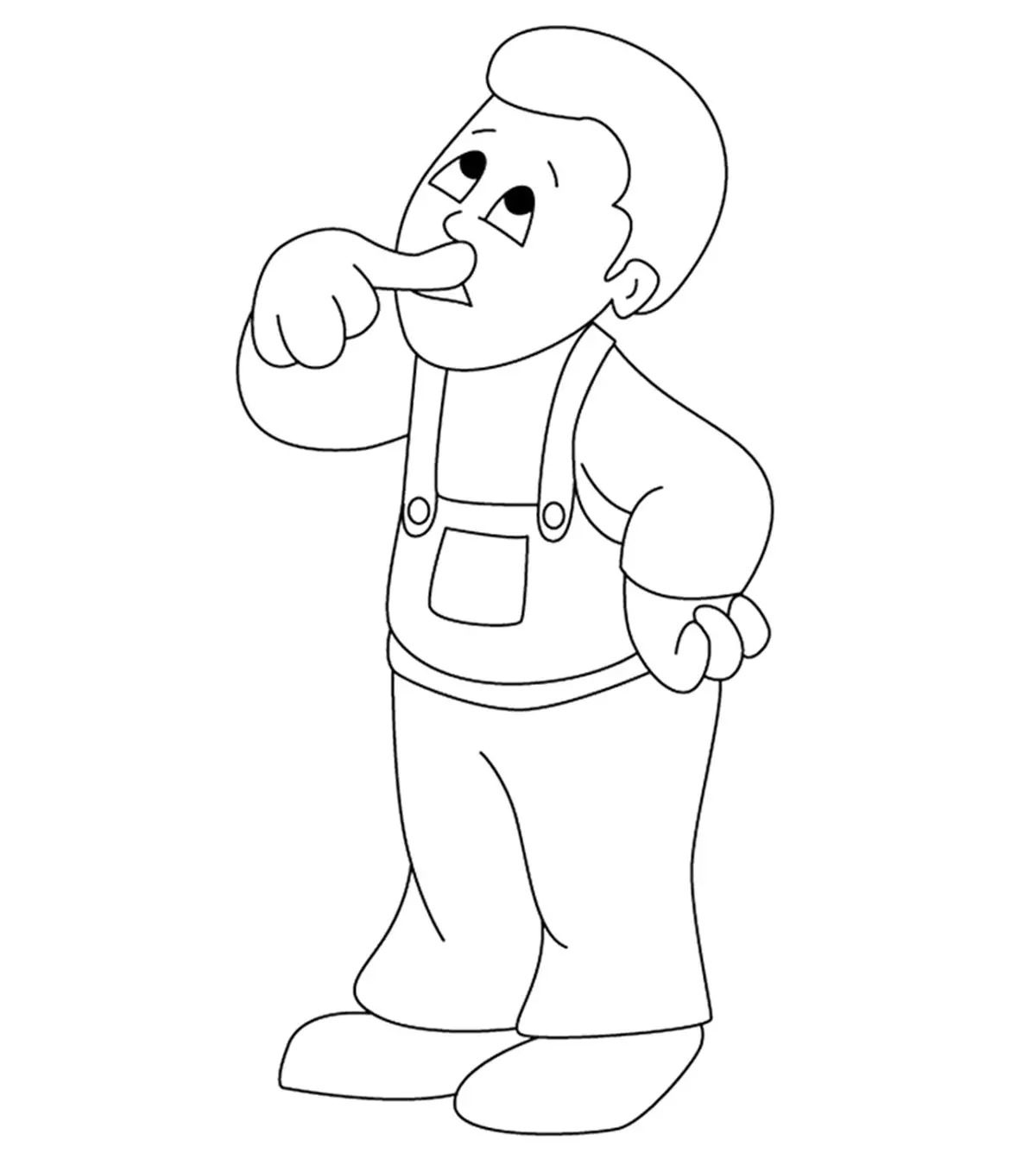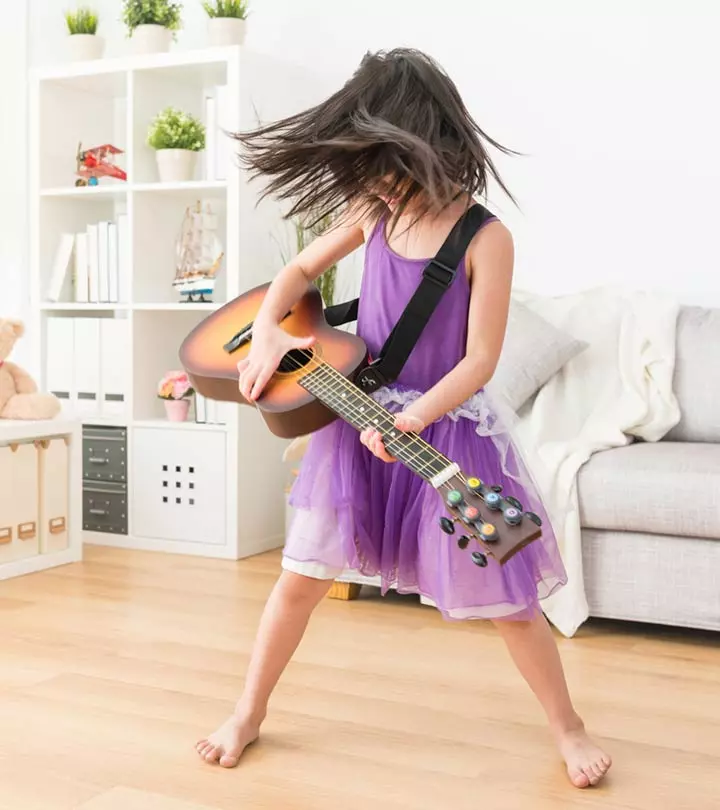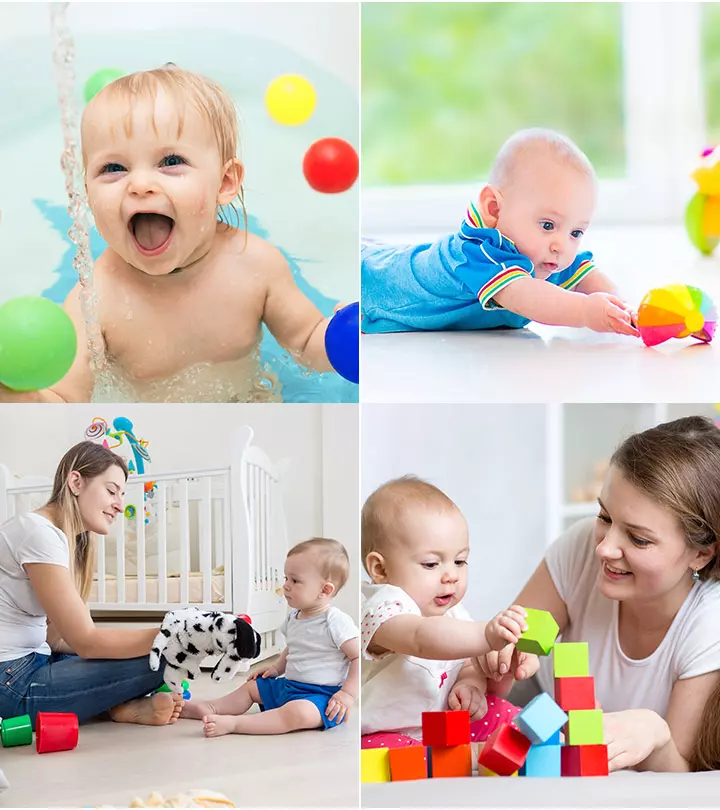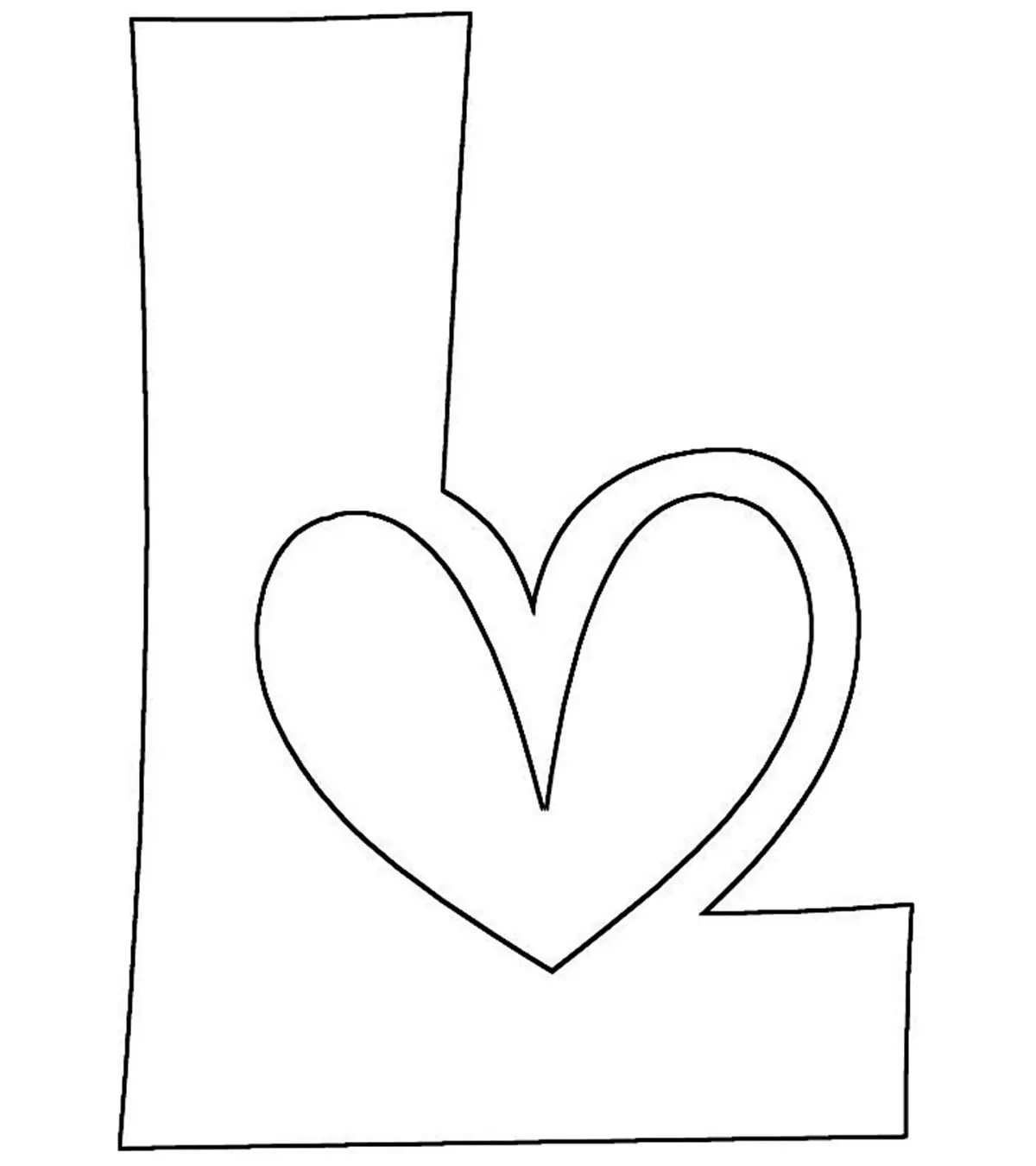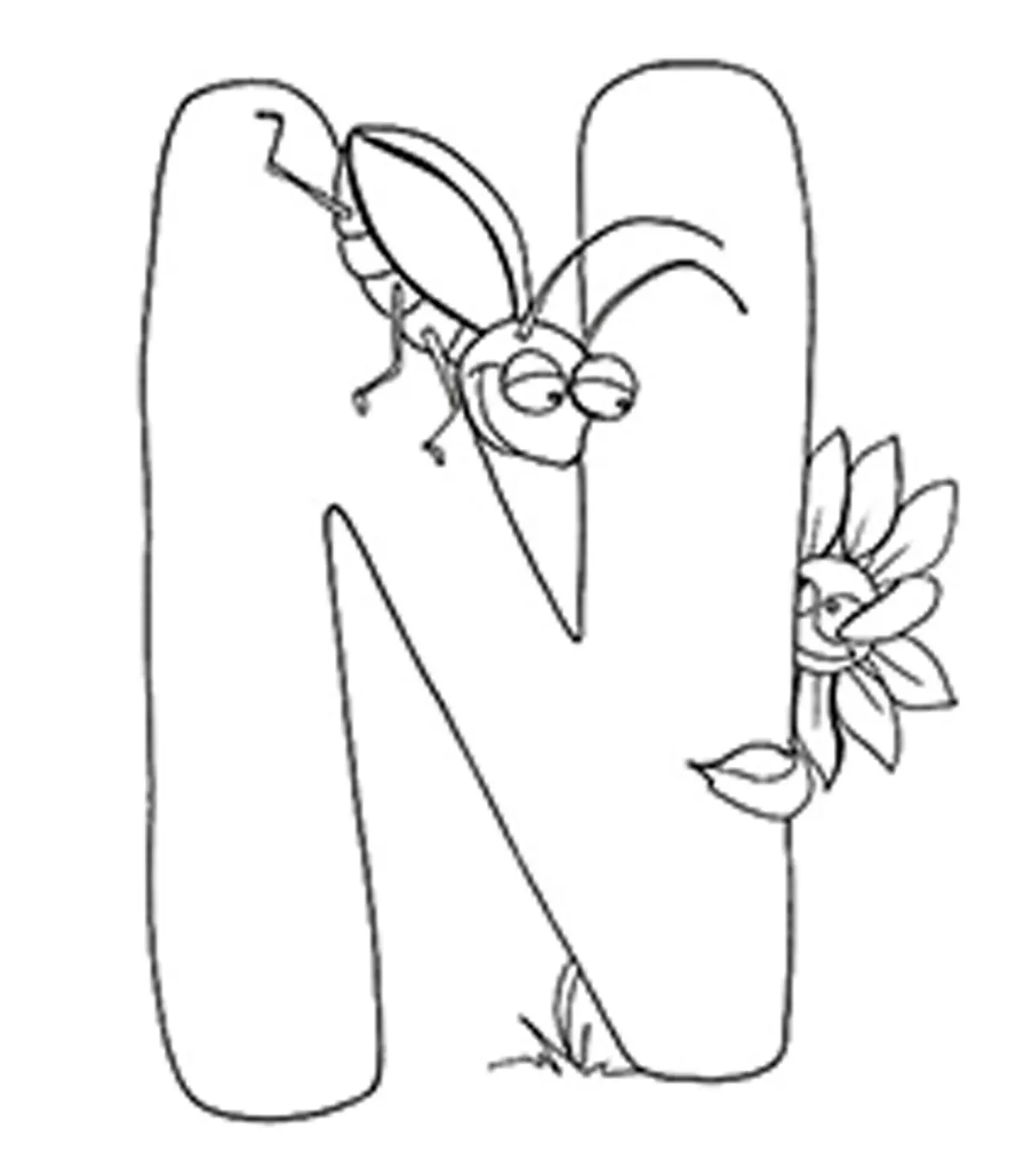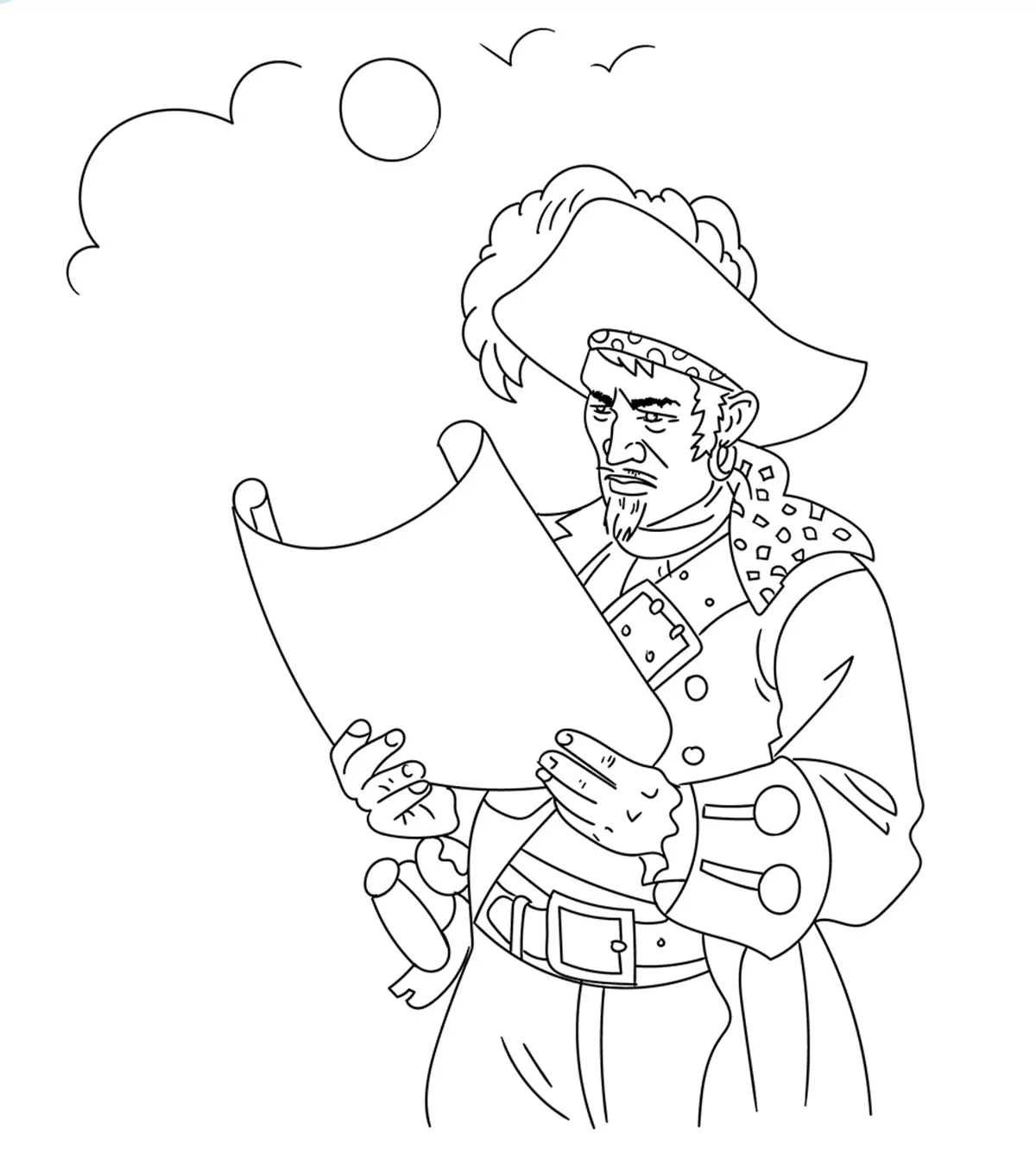
Image: MomJunction Design Team
Teenagers go through a series of socio-emotional and physical changes, which can be hard to deal with by themselves. Therapeutic activities for teens refer to a range of interesting activities that would be beneficial to work on their behavior, thinking, and self-identification. To overcome self-doubt, anxiety, loneliness, and more, engaging in these activities will help them rejuvenate and be a great stressbuster. Therefore, here’s a list of such activities to help your teen. These activities are designed to help teens manage stress, enhance emotional well-being, and foster personal growth. These are not intended to replace professional therapy but to supplement and support mental health practices. Read on to learn more.

Key Pointers
- Teenagers can benefit from engaging in therapeutic activities.
- Art therapy, journaling, and physical activities can improve teens’ mental health.
- Team-building exercises, as group therapy activities, can enhance social skills and boost self-esteem.
- Practicing mindfulness and meditation can reduce negative thoughts and induce relaxation.
Therapy Activities For Teenagers
Several therapies can be recommended to a teenager, depending on their needs. The commonly used therapy types are individual, group, family, art, and music. The benefits of therapeutic activities for teens are significant, as these approaches can help them manage their emotions, develop coping strategies, enhance self-esteem, encourage self-discovery, and build resilience.
Individual Therapy Activities For Teens
In individual therapy, a teen would identify their problems by discussing them with parents. This self-awareness will help your child to be communicative by discussing the issues and receiving feedback (1).
1. My life CD

Music helps individuals express their feelings, moods, thoughts, and beliefs. For a teenager, who is filled with emotions, this activity will work on creating self-awareness by identification and expression of feelings.
- The activity involves creating a music CD consisting of teen’s favorite songs and storing the disc in a jewel case.
- Let the teen choose his playlist of favorite songs based on a theme. For example, a teen might choose upbeat tracks for a “happiness” theme or nostalgic tunes for “childhood.” This process may help them identify and acknowledge their emotions. Once the songs are chosen, use a computer to burn (write) the songs on the disc.
- Give your teen an empty jewel case, and let them beautify it by sticking glitter, tiny plastic reflectors, etc.
- Let the design of the jewel case match the theme of the music on the CD. So, if the theme of the music is “childhood,” then the jewel case’s design can represent the theme through bright colors. If the theme is “dreams,” the teen might use stars and glitter to design the case.
- Once the jewel case is ready, let the teen store the CD in it.
- Listen to the songs and discuss the motivation behind each song’s selection in the playlist. Ask open-ended questions like, “What does this song mean to you?” or “Why did you choose this track?”
Some additional CD activities that you can try are “my greatest hits” (focusing on self-esteem) or “listen to my future” (focusing on goals). A combination of choosing songs and designing a jewel box can help the child vent their feelings through art and creativity.
2. My letter to me

Writing activities are a powerful tool to help teenagers come out with their feelings. It allows the expression of sensitive emotions that might be difficult to convey verbally. Such activities can help the teen gain a better perspective of their emotions while also building confidence and self-esteem.
- Ask your teenager to imagine themselves in the future as an adult. What kind of person do they hope to become? For example, a teen aspiring to be an artist might write about the challenges they overcame and the success they achieved.
- Ask them to write a letter from their future to their present self. What advice would they give to their current self? For instance, a teen struggling to meet their set standards can write, “You are doing your best, and that’s enough. Don’t forget to enjoy the little moments.”
- Guide the teen if they are not sure how to begin.
- Once done, ask them to read it aloud (if they’re comfortable). In this process, guide them through the letter to help identify issues they are experiencing now and how they would like to feel about them in the future. This exercise may help them identify current challenges and find a sense of direction.
- If they like, they can decorate and frame the letter to use as a positive daily reminder. For example, a teen might decorate the letter with motivational quotes or symbols that inspire them.
An anonymous blogger and English teacher uses Snowball activity to teach essay writing. She says, ”Snowball writing is an activity that your middle and high school students will always remember. It can be used with almost any writing genre and is highly engaging for even your most reluctant writers. I use this method for narrative, poetry, descriptive, and essay writing. I even use it as an introductory icebreaker activity during back-to-school or a semester change (i)!”
3. Walk through the talk
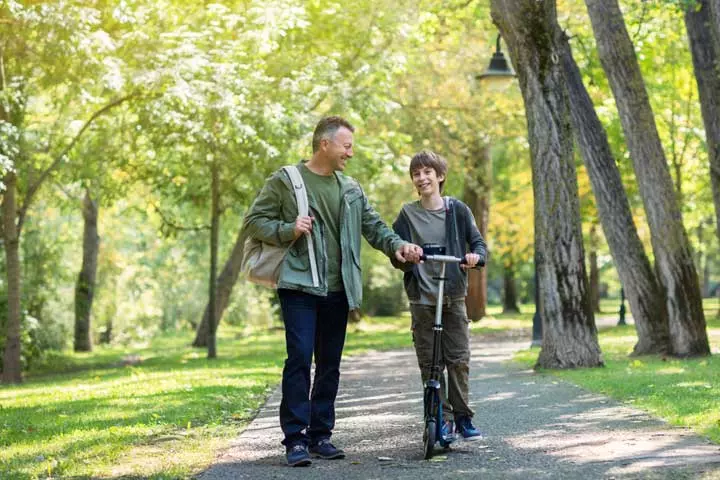
Talking is a basic way of expressing feelings, thoughts, emotions, and beliefs. It allows a teen to be comfortable with you (or their therapist) and build a strong, trusting relationship.
- Rather than having a formal therapy session in your home or at a therapist’s office, opt for outdoor activities and take your teen for a walk. You can go around the neighborhood or walk in the park or even visit a forest. It will elicit a more informal interaction. For example, a teen who enjoys nature might feel more at ease during a walk in the woods. Research shows that being in nature can improve mood, focus, and overall well-being (2).
- Strike a light conversation that talks about their days in school, their favorite activities, memorable experiences, and their weekend plans.
- Once the teen seems to get comfortable with the talk, progress towards critical thoughts and concerns that you believe need discussion.
- Normalize their feelings and avoid asking too many questions. Often it is helpful for teenagers to be able to relate to who they are talking to. Try and use a relatable story from your childhood to engage the conversation.
- What are their plans for the future?
- Is there any issue that you as a parent should know to help them?
 Did you know?
Did you know?- As the teen begins to open up, ask them clarifying questions to make sure you understand what they are saying. Teenagers are moving into adulthood, therefore, it is important for them to begin to increase in their decision making. Provide them with advice, but make sure they do not feel as if they are being lectured. You can also share relatable stories from your own life to help normalize their emotions and build trust.
4. Animal-Assisted Therapy
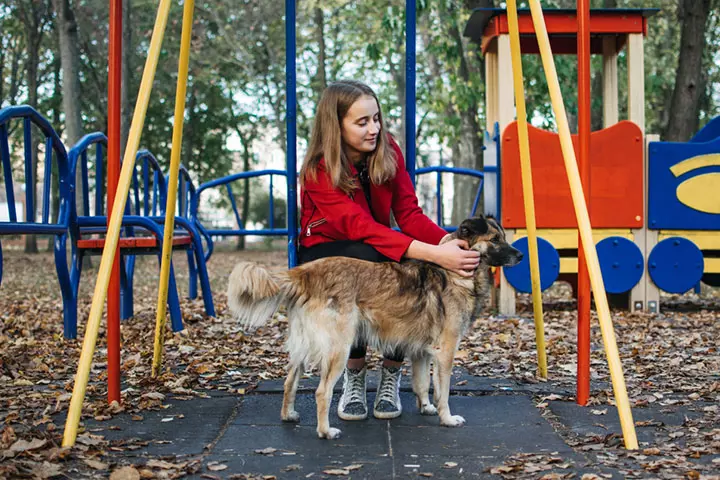
Interacting with animals may help lower cortisol levels and boost serotonin and dopamine levels, which could alleviate stress and improve mood (4). Additionally, animals provide a non-judgmental space for individuals to express their emotions and feel comforted. Hence, an animal-assisted therapy can be a great exercise for teens, especially if they love animals.
- Make the teen spend some time with an animal, like a dog, cat, or rabbit, in a peaceful outdoor area or a familiar indoor space. For this, you may take them to a pet care center, an animal shelter, or even a friend or family member who has a pet.
- Gently introduce the animal to the teen. Let them approach and interact with the animal at their own pace to build trust. For instance, start with simple gestures like offering treats or gentle pats.
- Encourage the teen to interact with the animal using verbal or non-verbal cues.
- After the session, ask how the teen felt, what they enjoyed, and whether they felt a sense of joy. Help them understand the benefits of the interaction through these questions.
5. Motivation Jar
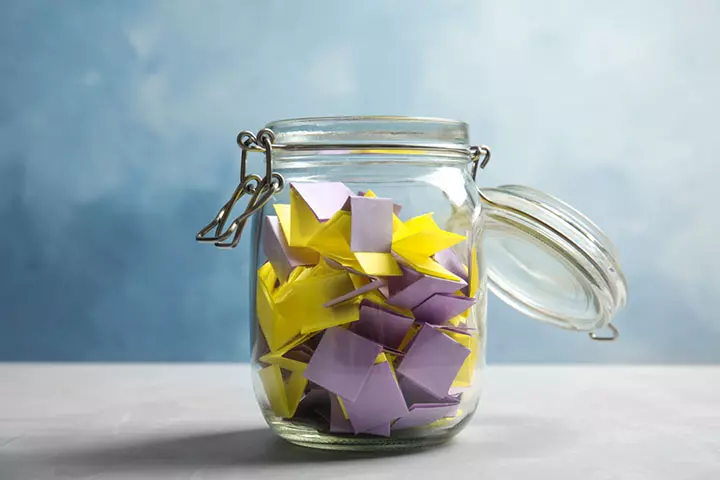
Motivational activities can help enhance mood, boost self-esteem, and improve resilience. They can also help keep teens inspired and uplifted. Moreover, they keep teens engaged in daily positive reflection, which can help them develop a positive outlook on life (5).
- Buy a motivation jar from the market or encourage the teen to make one from scratch at home.
- If they want to make a motivation jar at home, provide them with all the necessary items, like a jar, small paper chits, pens, etc.
- Ask them to write motivational quotes, affirmations, or positive thoughts that resonate with them on the paper chits. Guide the teen to write affirmations or inspiring quotes on the chits, such as “You are stronger than you think” or “Mistakes are proof you are trying.”
- Once done, ask them to fold the chits and place them into the jar.
- Encourage them to draw a chit from the jar daily and read it aloud.
- Discuss how the quote, affirmation, or positive thought made the teen feel and what they learnt from it.
6. Blow And Burst The Balloon

Children and teens often bottle up emotions, which can strain relationships and negatively affect their physical and mental health. Therefore, releasing pent-up emotions becomes essential. Blowing and bursting balloons is an activity that can help young people understand the effects of holding onto anger and teach them constructive ways to express themselves.
- Give the teenager an uninflated balloon and ask them to think about a time they felt angry but didn’t show it. For example, a teen might think of a time they argued with a friend but didn’t express their feelings.
- Have them blow up the balloon until it bursts to release built-up anger.
- Give them another balloon and ask them to blow it up just enough so that it may not burst.
- Now, ask the teen to talk about what made them angry while slowly releasing the air in the balloon to help them gradually let out their anger. For example, they might say, “I was upset because my friend didn’t invite me to the party.”
- Let them speak for as long as they want. Once they are done, share your insights about the situation that made the teen angry to provide them with a neutral perspective.
7. Vision Board

This activity may help teens identify and visualize their goals. It may also serve as a motivational tool, reminding them of their dreams and aspirations. Increased self-awareness and the development of a positive mindset are some other benefits a vision board may offer, helping teens navigate their formative years with purpose and confidence.
- Provide all the required items, like magazines, newspapers, scissors, glue, pens, colors etc., to the teens.
- Ask them to brainstorm their goals and dreams in various aspects of their lives. These could be related to education, relationships, hobbies, or personal growth.
- Now, ask the teen to cut some pictures from magazines or newspapers that best describe their goals and paste them on the vision board in a specific order. They may also take printouts and use them to create a vision board.
- They can add images of a university they want to attend, a sports team they want to join, or a hobby they want to pursue, such as learning guitar.
- Let them decorate their vision board the way they like to allow a free expression of emotions.
- Once done, encourage the teen to discuss their vision board. For instance, they might say, “I added a picture of a guitar because I want to start lessons this year.” In the process, ask them a few questions about their plans to achieve their goals. You may also share some advice and guidance at this point to help the teen feel more engaged in the process.
Group Therapy Activities For Teens
Several teens slide into isolation and loneliness due to their emotional and social issues, but participating in support groups can offer them peer support and a sense of community (6). The activities in group therapy aim to foster resilience and problem-solving skills, while also promoting a sense of shared experience and community. Besides, it helps them realize the value of emotional regulation and support that facilitates healing and recovery.
8. The fear cap

This simple activity is often used as an icebreaker and helps identify and recognize fears and negative thoughts. It also helps develop confidence, self-esteem, and trust in teens. For instance, a teen might write, “I fear failure in school.” When another participant reads it aloud, others may share similar fears, fostering a sense of understanding and connection. The activity suits better with a group where members are familiar with each other.
- Ask all the teens to sit in random order with a pen/pencil and paper.
- Give each teen five minutes to write their deepest and darkest fears on paper.
- After five minutes, collect all the papers and place them in a cap.
- Each member will draw one paper, read it aloud, and guess who wrote it.
- It will help teens share their thoughts and complex emotions, like fear. Besides, they will also get to know each other better.
9. Human Knot
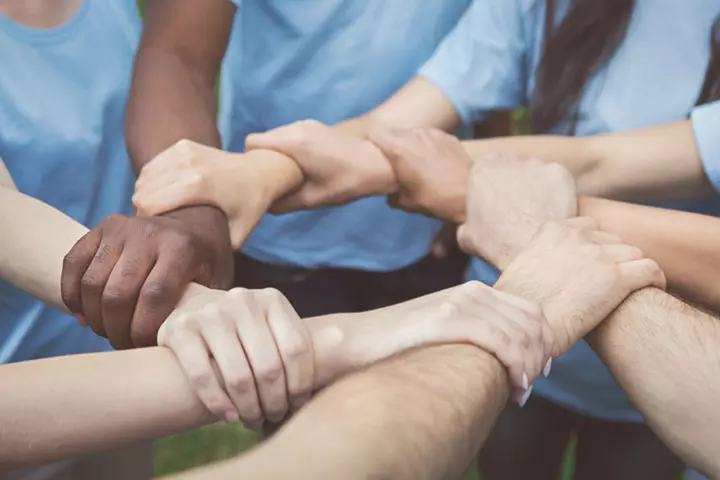
It is one of the most popular team-building exercises that fosters communication, collaboration, and problem-solving skills. It provides individuals with the opportunity to work in a group, which also helps refine their conflict management and resolution approaches. Additionally, studies suggest that activities requiring collaboration can enhance group cohesion and improve conflict-resolution skills (7). During the activity, one teen might suggest a solution, such as, “Let’s try turning clockwise together,” while another counters with a different idea. This interaction teaches compromise and listening skills.
- Instruct all the teenagers to stand in a circle, facing inward. It is usually best to have 5 to 10 individuals for this activity, though it can work for a larger group as well.
- Ask them to stand closer and hold hands with the people on either side of them so that each person holds hands with two people across from them.
- Once everyone is holding hands, ask the group to move around, stepping over and under each other’s arms, twisting and turning to create a tangled knot of arms.
- Now, instruct the group to untangle the knot. During the process, encourage them to communicate positively with each other.
- After the group has successfully untangled themselves, gather them in a circle. Ask each participant to share how they felt during the activity. Encourage them to share any challenges they faced and how they overcame them with positive thinking.
10. Gardening

Sowing a seed and watching it grow into a plant is a fulfilling experience. It is why grading is considered a therapeutic activity that teaches patience and instills a sense of responsibility. It fosters a sense of purpose that can have significant emotional and mental health benefits. Additionally, working with nature has been shown to reduce stress and improve mood (8).
- Provide each teen with the required gardening tools, like gloves, seeds, hand trowels, garden forks, etc.
- Let them select the seeds of their choice and assign each of them some space to sow seeds. Alternatively, you may divide the teenagers into small teams, with each team assigned a specific task, like planting, watering, and weeding.
- Once they are done sowing, ask each participant how they felt about working together. Tell them to share their experiences and thoughts about gardening and how it can positively impact lives.
- You can also ask them to tend to the plant every day and check in with how they feel after watching it grow over several weeks.
11. Mindful speaking

Mindful speaking is a great therapeutic activity that focuses on communication and mindfulness in participants. These two skills are essential for the management of emotions in teens.
- Make a group of teens sit in a circle.
- Inform the group about the rationale of the activity. Tell them that the activity is for developing mindful speaking by following three core principles of mindful speaking:
- slow down and bring yourself to the present moment
- analyze before speaking; emotionally and rationally
- reflect about the effects of what you said and how others felt about it
- Each teen will have to take turns to be the speaker, while the other members will listen.
- The speaker can pick any theme, such as their favorite holiday. The stipulated time for each speaker would be three minutes.
- Once everyone has finished talking, allow a reflective moment. You can discuss with all the teens about how they feel to speak mindfully compared to when they usually talk. For example, if a teen shares their favorite holiday memory, listeners may provide feedback on how the speaker’s story impacted their emotions.
12. Kind Hearts

Kindness is a highly valued virtue that teaches people to be empathetic and compassionate toward others. Indulging in acts of kindness, such as volunteering for a cause or helping someone in need, fosters positivity. Research shows that practicing kindness can increase serotonin levels and reduce stress (9). It also helps individuals experience joy and a sense of purpose that helps them become better humans.
- Provide all the participants with plain paper and a pen or pencil.
- Ask them to sit in a circle, facing inward.
- Instruct each participant to compile a list of kind gestures they want to undertake, such as helping a friend, helping a classmate with homework, engaging in volunteer work, or organizing a donation drive.
- Motivate them to think creatively and brainstorm innovative ways to contribute positively to their community.
- Now, let the participants take turns sharing what activity of kindness they want to take up and why.
- Encourage all the participants to give their input to make each other’s acts of kindness more effective and rewarding for themselves and the community. For example, a teen might plan to organize a neighborhood cleanup drive and receive ideas from the group on involving local businesses or promoting it through social media.
13. Spot the strength
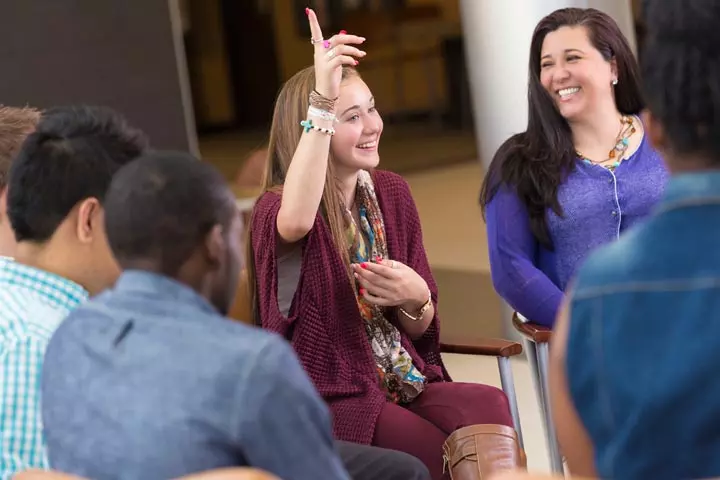
This is one of the teen team-building activities designed to help them identify and recognize psychological or character strengths in themselves and others. It even enables them to receive feedback about their strengths from others.
- Form a group with five to eight teens and make them sit in a circle.
- Ask them to share a positive story, one at a time. These stories could be any achievements or accomplishments in any domain of their life.
- The listeners make notes of the strengths they identify in the story.
- Once the story ends, ask all the group members to give feedback regarding the strengths observed. For example, if a teen shares how they managed to organize a school event under tight deadlines, the group should identify strengths like time management and leadership.
- Each group member reads out the strengths that they identified in the story and the reason they chose it.
- Once every team member has shared their story, have a discussion where the teens share their feelings about the stories, their observation, and learning.
- This activity allows team members to know each other’s strengths and ways to inculcate them. Positive responses from each other will also help them heal.
14. Laughter Yoga

Laughter yoga combines laughter exercises with deep breathing techniques to reduce teen stress and promote relaxation. It is an effective way to alleviate tension, boost mood, and promote overall well-being, which is necessary to have a happier outlook on life (10).
- Ask all the participants to sit on the floor equidistant from each other.
- Lead them through a series of laughter exercises for a set time period. Begin with a simple exercise like “lion laughter,” where participants stick out their tongues and laugh loudly.
- Encourage them to let go of inhibitions and embrace the joy of laughter, even if it feels awkward or forced at first.
- Culminate the yoga session with deep breathing exercises and guided meditation to help teens feel relaxed.
- Once done, ask each participant to share how they felt during the yoga session. Encourage them to share ways to make the yoga session more effective and rewarding.
15. Gratitude mapping
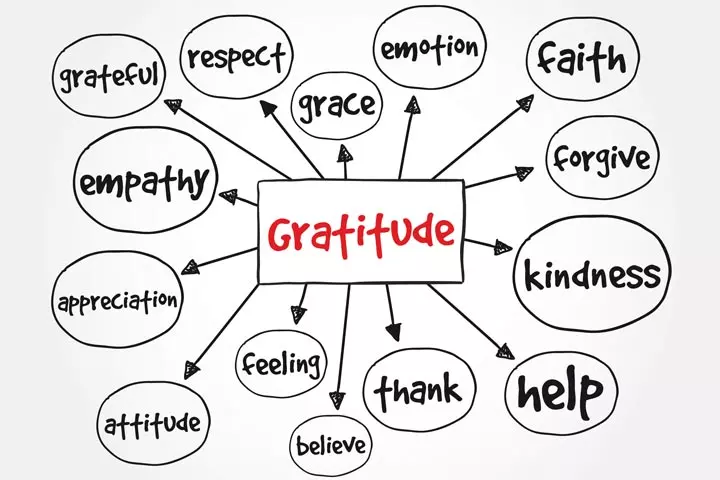
This engaging activity gives the teen a chance to be creative while expressing themselves. Research suggests that practicing gratitude enhances mental well-being and reduces depressive symptoms (11). This activity provides teens a chance to focus on positive emotions derived from positive aspects of life.
- Make groups with three to five teens each.
- Instruct all the groups to take five minutes to remember some good things that they are thankful for in their lives. Each group picks one set of three to five good things and reasons for gratitude.
- Ask each group to write these things on a whiteboard along with the reasons. Keep the whiteboard turned away from the remaining groups.
- Invite the next group to see what the previous group has written. Now, this step is about drawing connections between the ideas they can see.
- For example, if the previous group wrote that their favorite thing is their house, and the gratitude is love and care. The next group will have to write about things that remind them of love and care.
- The group then also writes their favorite five things, and the next group then maps the gratitude. Continue the activity until all groups have the chance to map gratitude and state their good things in life.
- Once all the group members have taken their turn, turn the whiteboard towards all of them and discuss:
- What is gratitude?
- Why do we feel gratitude?
- How is gratitude helpful in developing positive self-esteem?
This activity, rooted in positive psychology, creates a list of all the good things in life and the associated gratitude. It can help each teen realize that there are so many wonderful things in life to feel happy about.
16. Two truths and a lie
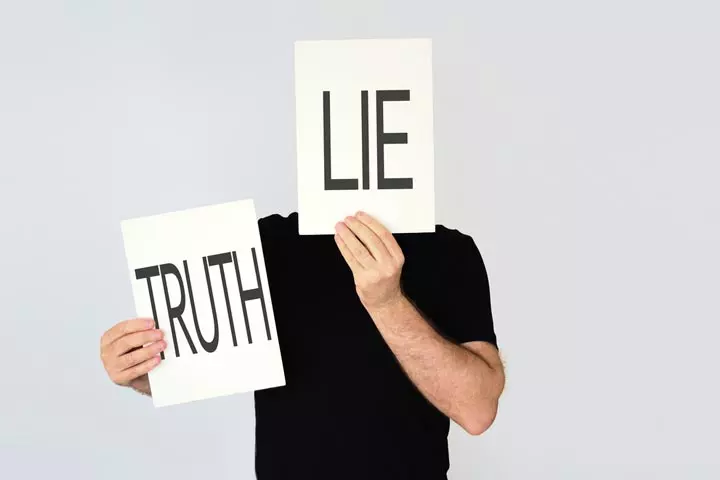
This activity is great fun when group members are familiar with one another. The activity allows each member to share three things about themselves, of which two are true, and one is a lie. The other members need to separate the lie from the truths. This activity provides an opportunity to learn exciting things about each other.
- Give five minutes to the group members to sit and think about interesting aspects of their life.
- Then, give them three minutes to write down three things or facts from any aspect of their life. Two points are true, while the remaining one is a lie.
- Randomly select a group member and ask them to read their two truths and a lie. The other group members guess which two out of the three facts are true and which is not. For example, a participant might say,
- “I’ve traveled to three different countries.”
- “I own a pet snake.”
- “I’ve never eaten pizza.”
- The group debates, has to find out which is the lie and in the process learns new things about the person.
- Once all the members have finished, discuss the activity, and encourage positive social interaction between the teens.
17. Compliment Circle

Giving and receiving compliments is a therapeutic activity that boosts one’s self-esteem. It makes an individual feel good about themselves and know about their likable qualities, which motivates them to work on themselves continuously. This activity is a good choice for a group of teens who know each other.
- Make the teens sit in a circle, each facing inward.
- Give each participant a piece of plain paper and a pen or pencil.
- Instruct them to write down some likable qualities of the person sitting next to them within a stipulated time.
- Once done, ask each participant to compliment the person sitting next to them by elaborating on their qualities. It will help teens learn about themselves and each other better. For instance, participants can say something like, “I admire how you always stay calm during group discussions. It shows great leadership qualities.” Such feedback helps build confidence and recognition of individual strengths.
18. Drama therapy
Storytelling is a way to heal oneself. This activity facilitates role-playing so that each group member can understand and process emotions that they find difficult to express otherwise. It also gives them a chance to exercise empathy and self-reflection. Additionally, role-playing can create real-life learning experiences, build skills such as negotiation and teamwork, and inspire and motivate teens (12).
- Assign roles to each member and give them a specific scenario. Ask them to react the way their character would in that particular situation. For example, a group could act out a scene where a teen is stressed about exams, and their peers provide support and solutions. This helps participants learn coping strategies and practice offering empathy.
- Give them time to think and discuss amongst themselves so they can develop a brief storyline and dialogue.
- In some cases, you may also try the role reversal technique. For instance, if two members have had a conflict, you can ask them to react the way they would have reacted if they were the other person.
- Once all members are done, ask everyone to reflect on what they experienced today and how they can adapt daily.
19. My Role Model

Many teens have role models who influence their behavior and choices. They help shape teenagers’ understanding of who they are and who they want to become. This activity helps teenagers learn about their role models in depth and develop a rationale as to what they like in their role models and why.
- Provide all the participants with a pen or pencil and plain paper.
- Instruct them to write a paragraph about their role model within the stipulated time, highlighting what they like about their role model and why. For example, one can write about a teacher or mentor who taught them resilience, saying, “I admire my math teacher for always staying patient and encouraging me to keep trying. I want to be as calm and supportive as they are.”
- Once done, ask each participant to read their paragraph aloud and explain what qualities of their role model they want to imbibe and why.
- Encourage the group to discuss their role models and share their feelings about them. This activity will help teens communicate and learn more about each other.
20. Paper Palms

Writing about each other’s strengths and admirable traits fosters mutual respect and strengthens relationships. It helps an individual steer away from negativity and focus on others’ positive attributes. Moreover, it helps boost self-esteem and encourages positive thinking.
- Provide the participants with colorful paper, pencils, pens, colors, and scissors.
- Ask each of them to trace their palm on the paper using a pen or pencil, and cut out the shape.
- Tell everyone to write their name in the center of the paper palm and pass it to the person sitting next to them.
- Ask the individual to jot down one admirable quality about the individual whose name they see on the paper palm. Teens can add comments like “You’re a great listener” or “You have a creative mind.”
- Continue the exchange until each paper palm has circulated through the group. When the hands return to their respective owners, invite everyone to read the feedback.
Reading these compliments reinforces their sense of worth and motivates them to maintain those positive behaviors.
Art Therapy Activities For Teens
Art therapy is a therapeutic combination of art and psychology that helps individuals overcome emotional or psychological challenges. These activities focus on developing self-awareness, exploring emotions, and addressing unresolved conflict or trauma. Through art therapy, people can improve their thinking abilities and physical coordination, build confidence, understand themselves better, and develop stronger emotional coping skills. It also helps them gain new insights, interact better with others, and work through their difficulties. Some practitioners even use art therapy to promote positive changes in society and environmental awareness (13). All these are important aspects to develop self-confidence and fine communication skills in an individual.
21. The postcard activity
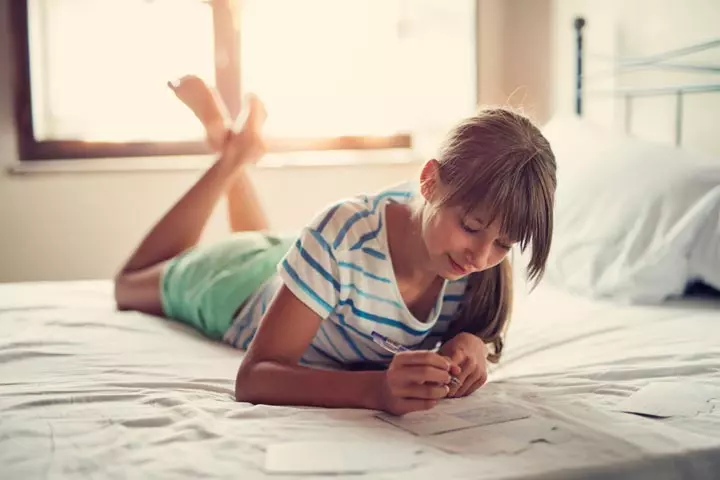
This art therapy activity is a self-discovery exercise that can be used for individuals or groups. The activity helps teens express their negative feelings or conflicting opinions to someone without having to say it to them. It might help dissuade the fear to face communication among teens.
- Buy a postcard for each teen. You can also print a template of a postcard on a piece of paper.
- Distribute these postcards among teens and ask them to recapture a situation or person that they feel/felt anxious, angry, frustrated, sad, or upset about.
- Give the group some time to go into the flashback and think about:
- what happened and how it felt
- what they would like to tell the person about the experience and how it made them feel
- Ask the teens to draw their experience on the blank side of the postcard. Use the lined side to write what they wish they said.
- Tell them that they have the freedom to express what they felt or still feel about the experience.
- For example, a teen upset about a recent argument with a friend might draw two individuals facing away from each other. On the lined side, they might write: “I felt hurt when you ignored me. I wish we could talk and sort this out.”
- Once they complete drawing and writing, use what they drew and write to explore their emotions. Discuss with each of the participants about how they might begin to work towards a healing resolution.
22. Self-Esteem Mirror
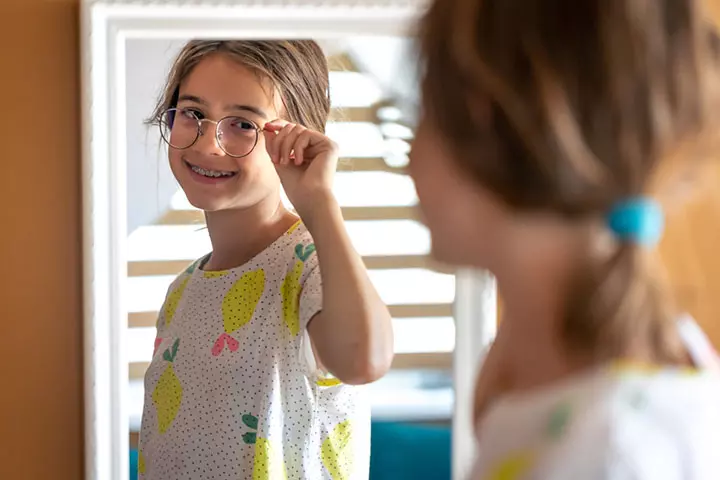
Positive self-esteem boosts one’s confidence, which helps individuals cope better with life challenges and setbacks. This interactive activity is a powerful technique that uses a mirror to positively alter the way an individual perceives themselves. Having positive self-esteem reduces stress and promotes mental well-being (14).
- Give each participant a pen or pencil, chart paper or poster board, glue, colors, and decorative accessories, such as beads, fake pearls, pompoms, laces, etc.
- Ask them to draw a big mirror on the chart paper or poster board. Let them be creative and decorate the mirror to their liking.
- Now, instruct them to write down their strengths, achievements, and good qualities inside the mirror, symbolizing these attributes as their reflection in the mirror. For example, a teen might write “kind,” “hard-working,” “great at art,” or “helpful friend.”
- Once done, ask each teen to show their mirror and share what it reflects.
- Tell the participants to keep their respective mirrors in their rooms so that they may look at them daily and feel proud of themselves. Over time, seeing these positive words helps them reframe negative self-perceptions, boosting their self-esteem and mental well-being.
23. Positive Jewelry

Jewelry-making is a relaxing exercise that sets a teenager’s creativity free. It provides them with an opportunity to express themselves using various decorative materials. This activity allows them to make meaningful art pieces that reflect their core beliefs and values and serve as a reminder of their strengths and capabilities.
- Provide the teens with a jewelry-making box or individual jewelry-making items like beads, pearls, threads, pliers, scissors, glue, needles, pliers, hooks, jump rings, chains, wires, etc.
- Let them be creative and create an artful jewelry piece that they could wear daily. If they wish, allow them to use colorful permanent markers to write positive affirmations or quotes on these jewelry pieces and convert them into artistic reminders of one’s qualities and abilities. For instance, a teen might write “I am enough” or “Strength in every challenge” on their piece.
- Whenever they feel anxious about something, they can wear this necklace to remind themselves to stay focused and persevere.
- Once done, ask everyone to show their jewelry item(s) and explain what they represent or symbolize.
24. Creative collage

It is an amusing and engaging therapeutic exercise. In this activity, teens create a visual representation of their core beliefs and values through their imagination and creativity. Realizing core values is important as it helps develop coping skills and strategies that are vital to guard mental health.
- Ask the teens to focus on their core values. Explain it to them through examples of core values, such as taking the initiative, having fun, ensuring growth and development. It might include qualities like honesty, creativity, adventure, or kindness. A core value can be anything they feel strongly about or what they feel good about.
- Once the teen understands the meaning of core value, ask them to focus and answer the following:
- What are the positive words that come to them when they focus on their core value?
- What are the images/colors and shapes they feel are associated with these words?
- Ask the teens to answer the above questions through a collage. They can select images, words, phrases, or colors from magazines and newspapers to compile a collage. Let them select words, colors, and pictures that best represent their core values.
- For instance, a teen who values “growth and development,” can create a collage that includes images of a growing tree, a pile of books, and the word “progress,” thereby expressing their belief in constant self-improvement.
25. T-Shirt Painting

Painting t-shirts can be a fun and creative activity for adolescents to self-express and explore their artistic talents. Creating an art piece that reflects one’s emotions and thoughts gives a feeling of accomplishment that uplifts the mood and boosts self-esteem.
- Provide all the essential items, like light-colored t-shirts, fabric paints, brushes, stencils, masking tapes, etc., to the teens.
- Let them choose the items they want based on the design or pattern they have in mind.
- Encourage them to be creative and paint a t-shirt that best expresses them and their emotions. By painting a t-shirt with bold colors and abstract patterns, teens can express their frustration in a way that feels productive.
- Set a time limit for painting, say 15 minutes.
- Once done, ask them to show their t-shirts to the group and share their motivation behind choosing a specific design and color.
26. Alter the photo
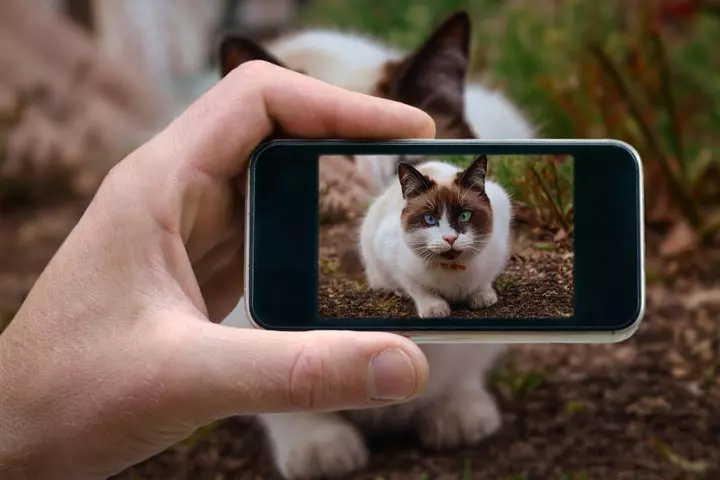
This activity helps boost the self-esteem of teens by providing them innovative ways to self-express. When they alter the image, they are also venting out their emotions and alleviating their stress.
- Provide all the needed materials, like magazines, newspapers, cutters, scissors, glue, colors, pens, etc., to the teens. Teens can play it individually or in groups.
- Let each teen choose an image from the magazine, say an image of a cat. Then, let them use their imagination to modify the cat’s picture, say by giving it a cute smile or blue eyes. Allow the teens to let their emotions out without worrying about their artistic skills.
- Set a timeline for completion, say 15 minutes.
- The activity can be made more insightful by letting the teens discuss the altered image and the ideas behind alteration. For instance, if a teen added a bright color to a dull image, ask them why.
27. Dreams And Challenges Tree
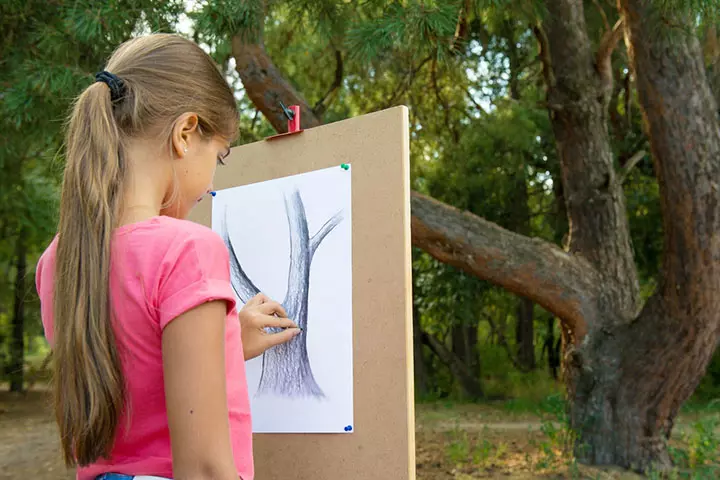
This activity is similar to creating a vision board. Besides visually representing their goals, this activity can help teens identify potential barriers to their success and find solutions. It will also serve as a token of encouragement to keep them motivated.
- Provide all the required material, like poster board, paint brushes, colors, etc., to the teen.
- Ask them to draw a large tree with several leaves and well-defined roots on a poster board or a painting canvas.
- Tell them to write their dreams and aspirations on the leaves. For example, one leaf might say “Become a doctor” or “Learn to play the guitar.” Ask them to add their fears or potential challenges on the roots. This could include things like “Fear of failure” or “Lack of resources.”
- Discuss their goals/dreams and fears/challenges, helping them find effective ways to navigate the hurdles and attain desired outcomes.
28. Expressive Finger Painting
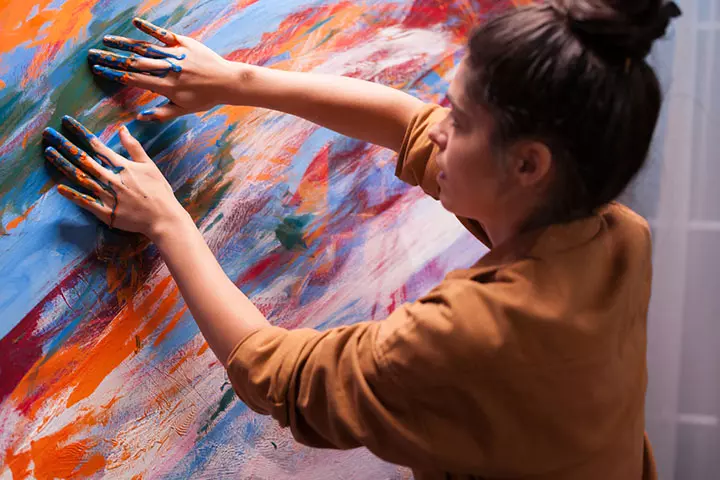
This activity allows teens to paint a canvas using their fingers, allowing them to freely express themselves. Engaging in this artistic activity can help reduce stress and foster a sense of self-worth. This tactile experience can increase mindfulness and boost confidence.
- Provide all the required supplies, like non-toxic finger paints, painting canvas, aprons, wipes or towels, etc., to teens.
- Tell them to paint a canvas based on their present thoughts, emotions, and feelings. For example, a teen might paint vibrant colors to reflect joy, or darker tones to express sadness or frustration.
- Set a time limit for completion, say 20 minutes.
- Once everyone is finished painting, ask each participant to show their artwork and explain what it expresses. Encourage them to reflect on the process and share how painting made them feel and what they learned from it.
29. Creating sculptures

Sculpture-making is a fantastic addition to art therapy activities as it enables teens to express through constructive creativity. Besides, it helps in stress management, coping with anxiety, and other external pressures.
- Provide the teens with all the necessary materials, like colored dough or clay, water, rolling pin, calipers, scrapers, frames, etc.
- Give them a time limit within which they have to prepare a sculpture. Let the teens be as creative and imaginative as they want. For example, they can shape a small figure to represent a family member or create an abstract form that symbolizes a personal challenge.
- Once the activity is complete, let the teens discuss what they prepared and the motivation behind their creation.
- As the teens discuss their creation, they boost their self-confidence.
30. Heart Mapping
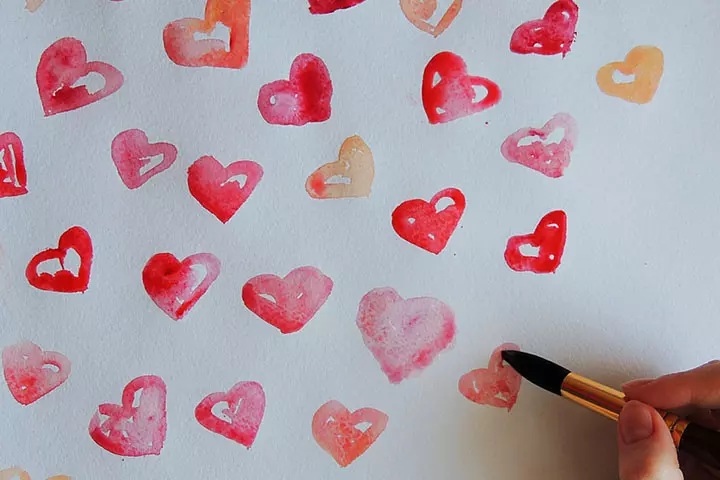
Heart mapping helps teenagers enhance their self-worth and cultivate positivity. This activity involves drawing representations of their heart and mapping out various emotions, feelings, and thoughts that define who they are.
- Provide all the required items, like plain white papers, paints, brushes, colors, pens, pencils, etc., to teens.
- Ask each participant to paint a depiction of their heart on the paper using the provided items.
- Encourage them to write their interests, hobbies, strengths, weaknesses, and character traits in the heart to describe themselves. For example, a teen might draw a soccer ball to represent their love for sports.
- Set a time limit of 10 to 15 minutes for task completion.
- Once everyone is done, let participants take turns sharing their heart maps with the group. Explain the elements they have included and what they mean to them. For instance, a teen might say, “I included a drawing of a book because reading helps me feel calm.”
31. Origami

Origami is an artistic practice that involves folding paper to create designs. Engaging in this activity may encourage positive behavior, enhance mental clarity, and reduce anxiety (15). It may also help individuals express their deepest thoughts and feelings through their art.
- Provide the teens with all the essential items for the activity, like origami papers, scissors, creasing tools, decorative items, etc.
- Instruct them to make an item that best describes them and their abilities. If needed, give them an origami design and instruction manual to locate and make the desired pattern. For example, they could fold a crane to represent peace or strength.
- Encourage them to pay attention to the details and be as creative as possible.
- Set the time limit for the activity, say 30 minutes.
- After the activity, encourage each participant to share how the process of making origami helped them feel.
32. Paint the journal
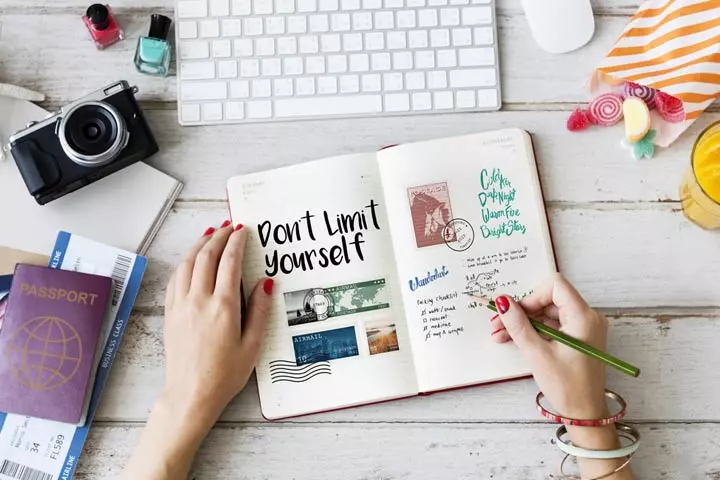
Some teens have difficulty expressing themselves verbally. For them, writing a diary or journal is a way to express. But self-expression is not limited to words. Painting can also help them connect to their emotions and express them effectively. It will eventually boost their confidence and self-esteem.
- In this self-care activity, ask the teen to maintain a journal in which they can paint or draw illustrations that represent their feelings.
- They can draw or paint anything that they feel can help them express themselves better.
- You can assign an emotion, like happiness, fear, etc., and the teen can draw an illustration representing that emotion. For example, if they’re feeling anxious, they might paint swirling, chaotic colors; if they’re feeling happy, they might create bright, cheerful patterns. Let the teen take their time to draw.
 Trivia
TriviaMusic Therapy Activities For Adolescents
Research shows that therapy practitioners find music successful in helping troubled adolescents engage in the therapeutic process with minimum resistance (17). It happens because teens connect with music with relative ease. Music can be a medium for a teen to express their feelings, alleviate stress, and overcome isolation. Additionally, interactive musical activities like singing, playing instruments, and dancing can help teens improve their motor skills and interact better with others (18).
33. Drumming

This activity facilitates the expression of emotions and provides an outlet for teens with depression. This activity can be performed individually or in groups.
- Provide your teen age-appropriate drumming instruments, such as a drum or hand percussion.
- Ask them to close their eyes and vent out on the drum.
- You are likely to notice a rhythmic change in the drumming as the teen begins to vent out their emotions. For example, if a teen is feeling angry or frustrated, their drumming may start out with intense, sharp beats. As they process those emotions, the rhythm will often become smoother and more controlled.
- The change in the rhythm is best felt when the activity is performed in a group.
34. Select your music

Select your music (commonly referred to as “music selection”) is an activity used for adolescents with difficulties in emotional regulation and management. The meditative practice helps teens develop self-awareness and acceptance.
- Ask the teen to select songs or pieces of music they like to hear the most. The selection can be based on a wide range of emotions that the teen wants to express. These can range from happy, upbeat songs to more somber, introspective music.
- Once the music is selected, ask the teen to sit in a comfortable place and play the music through their phone or CD player.
- If a teen is feeling sad, they might choose slower, melancholic songs that mirror their emotions. As they listen to music, they would get some memories associated with the music. It is an important part of the process that helps healing by letting the emotions flow.
- Once the music finishes, discuss the experience that the teen had. It will help them have realization and acceptance of some of their deep hidden issues.
35. Musical emotions

This music therapy activity works in a group setting and helps teenagers identify and express emotions. It also helps a teen understand the way another teen/individual could show the same emotion.
- Ask the teens to sit in a circle.
- Fill a cup with small pieces of paper with each paper containing the name of an emotion.
- Turn on the music, and the teens begin to pass the cup among them. When the music stops, the teen with the cup picks a chit and reads the emotion. The challenge is to act the emotion without getting up from the place or saying anything. For example, if a teen gets “frustration,” they can act it out by clenching their fists or tapping their foot rapidly.
- While the teen acts, others guess the emotion. After the right guess, the paper is removed, and the cup is passed while the music is playing.
- When the music stops, the teen holding the cup picks the paper, reads the emotion, and enacts it.
- Once all the teens have taken their turn, discuss how to recognize emotion in others and what to do when you see someone expressing a particular emotion.
36. Songwriting

Songwriting helps a teen express their emotions constructively. It improves mental capabilities, such as self-regulation and positive social interaction.
- Guide a teen or a group of teens to write a song. The song can be based on any feeling that they want to express. They might write lyrics about their worries, fears, and hopes for success. The process of putting those feelings into words can help them gain perspective on their anxiety.
- Give them some time to write down the lyrics.
- Once the individual compositions are ready, you can ask the teens to sing the song. They can also play an instrument along.
- After each song, discuss the thoughts and feelings behind the inspiration of the lyrics and music composition. It will be helpful to highlight the emotions and feelings of the teen/s.
37. Music and Movement

Combining music and movement could be an excellent way for teenagers to release their pent-up emotions or feelings. Through this activity, they can constructively express their feelings without having the need to write or say anything.
- Find a spacious, comfortable area where your teen can move around easily.
- Ask your teen to choose a playlist with songs that bring out different emotions, like happiness, anger, or sadness.
- Encourage them to get submerged in the music and sway or move the way they like. Let the activity run for a stipulated time, say 20 minutes. A teen might select a fast-paced song to express anger through stomping and arm movements, while a slower, melancholic tune could inspire more fluid actions like swaying or gentle stretching, reflecting sadness or contemplation.
- Afterwards, encourage the teen to discuss how each song and emotion affected their movements. It can help them better understand and express their feelings.
Family Therapy Activities For Teens
Family therapy (or family counseling) is a mode of treatment designed to address specific issues that affect the health and normal functioning of a family (19). Identifying these issues is crucial to understanding their impact on the teen. This therapy type can be used to pass through a difficult period/transition or help with mental and behavioral health problems among the teen’s family members.
38. My happiest memory

This engaging and joyful activity enables a teen to focus on their positive memories of the time spent with their family. Remembering such memories can help a teen to stay positive. Research shows that recalling positive experiences can help cope with stress (20). This activity also gives each family member a chance to know the different perspectives associated with the same memory/incident.
- The family sits together at the dining table or in a circle on the floor.
- The teen talks about the happiest moments that they have experienced with their family.
- Here, the task is to recreate the memory by actions that could project the emotions. So, the teen will present the memory and feelingS associated with it through acting. If the happiest memory involves a family vacation to the beach, the teen can act out the joy of building sandcastles or swimming in the ocean. Another family member might recall the excitement of watching the sunset, while another could share how they felt relaxed reading by the shore.
- Each family member then shares their memory associated with the incident. They must share their memories through acting, too.
- After the activity, family members can discuss how a similar incident could impact different individuals in different ways.
This activity allows the teen to open up and share any differences affecting their positive relationship with the family.
39. Emotions Ball

This fun and engaging activity allows teens to share their emotions and feelings with their family. Participating in such activities can help teens identify and communicate their own emotions effectively. It also promotes empathy, as they understand others’ feelings through shared experiences.
- Write different emotions, such as happy, anxious, excited, and frustrated, at different places on a ball.
- Make all the family members sit on the floor or on chairs in a circle, facing each other.
- Now, give the ball to the teen and ask them to look at the emotion closest to their thumb and share a memory related to that emotion. If a teen’s thumb lands on “frustrated,” they might share a memory of struggling with a school project. A parent might then relate to the emotion by recalling their frustration at work, fostering mutual understanding. A sibling could share a moment of frustration during a sports game, highlighting shared emotional experiences within the family.
- Once they are done, tell them to pass the ball to the person seated next to them and continue the process until everyone has had a turn.
- Encourage the participants to delve into the details of their memory and contemplate its emotional impact. This exercise will help participants identify and express emotions, fostering empathy as they listen to and relate to shared experiences.
40. Candy go around

This fun and engaging activity supports interaction among teen and their family members.
- You will need a packet of M&Ms or a similar colorful candy.
- Randomly distribute seven pieces of these candies to each family member, and ask them to sort the candies by color.
- The teen tells the number of candies of each color.
- Each color is associated with a topic, and the teen needs to provide responses that correspond to the number of candies of that color. For instance, if the teen has two orange candies, they provide two responses for the topic associated with the orange color. Below is the list of topics/questions associated with each color.
- Red – words that best describe your family
- Green – ways/methods your family has fun together
- Purple – things your family needs to improve on
- Yellow – things that worry you
- Orange – things that make you happy
- Once the teen is done with his/her responses, ask them to pick another family member to answer the same questions based on the number of candies of the same color.
- Once all the family members had their turns, initiate a healthy discussion based on the answers given. Focus on the teen’s responses to understand the issues they are facing and what aspects of the family are responsible for it. For example, if the teen mentions that their family needs to improve on “spending quality time together,” brainstorm practical solutions such as planning weekly game nights or outings.
- Some of the questions that family members could ask the teen are:
- What was the most surprising thing you learned about other family members?
- How should you work towards making changes/improvements as suggested by the family?
41. Miracle Wand Question (MWQ)

The Miracle Wand Question (MWQ) is an engaging activity where each family member envisions a miraculous change that happens overnight. Research has shown that careful planning and thoughtful introduction of the MWQ help in uplifting the mood (21).
- Make all the family members sit on the floor or sofa facing each other.
- Tell the teen to envision a miraculous transformation happening while they are asleep, leading to remarkable positive changes in their life.
- Now, give them some time, say 10 minutes, to process their thoughts. For instance, the teen could say, “If a miracle happened overnight, I would wake up feeling confident about school. My parents would understand when I need space versus when I need support. We would have breakfast together every morning, talking about our day ahead instead of rushing out the door.”
- Once done, ask them to explain how that miracle would change their life.
- Continue the activity until everyone has had their turn.
- Once everyone is done sharing their changes, set up an open forum and encourage everyone to discuss their individual positive changes and the impact they may have on different family members.
42. Genogram
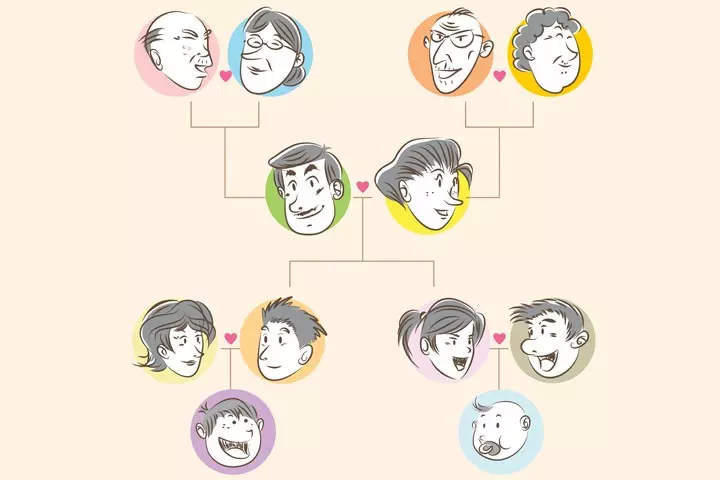
A genogram is a symbolic, simplified, yet detailed graphic representation of a teen’s family in generations. It can be used to represent a teen’s relationship with each family member and vice-versa. This technique could be used to manage emotional relationships and identify the strengths and weaknesses the family shares.
- This activity creates a simplified version of the genogram so that it is easy to interpret. Begin the activity by providing a pen, paper, and a red, blue, and green sketch pen to each participant.
- Assign a shape to each family member. For instance, the teen takes a circle, his/her brother takes a square, and so on.
- Each member draws their shape on one side of the page while drawing the other shapes, representing other family members, on the right side of the page in a column.
- Now, assign a code, which is a different type of line of a different color, to define a particular relationship. For instance:
- One green line = Friendly
- Two green lines = Close and harmonious
- One red line = Unfriendly
- Two red lines = Hostile
- One blue line = Manipulative
- Two blue lines = Apathy and lack of concern
You can add as many color codes you like based on how complex you want the activity to be.
- Each family member draws the lines between their shape and the shapes of their family member. The lines are drawn based on how they believe the other family member treats them.
- For example, consider a family of four:
- Teen draws two green lines to mom (close relationship)
- One green line to dad (friendly but could be closer)
- One red line to younger sister (current conflict)
- Parents might draw different lines, revealing perception gaps
- Once each family member is done drawing the genogram, reveal it to each other. Sit and discuss the reason for someone to give a specific code.
Tips For Parents
When your child reaches adolescence, you may have frequent arguments with your teens. Here are some tips that may help you and your child navigate through the adolescent years smoothly.
- Encourage open communication: Create an environment where your teen can freely express their feelings and challenges.
- Be involved: Make sure to be there for your teens. You can also participate in these therapeutic activities to support them and deepen your relationship with them.
- Seek professional help if needed: If you still notice your teen to be disturbed and stressed, do not hesitate to reach out to a counselor or a therapist who can help your teen.
Frequently Asked Questions
1. What are some occupational therapy activities for my teens?
Occupational therapy activities for teenagers depend on the challenges your child faces. They are generally used to treat children with developmental delays, problems with motor skills, physical movement, strength and balancing, visual processing, oral motor and sensory processing, social interaction skills, learning difficulties, and play skills. In addition, there is an array of activities ranging from simple physical exercises to writing, drawing, listening, and speaking to improve their condition (22).
2. How can mindfulness and meditation be beneficial for teens in therapy?
Mindfulness and meditation techniques benefit teens in therapy by helping them cultivate present-moment awareness, reducing stress and anxiety, fostering relaxation, and developing emotional resilience. Among the benefits of mindfulness and meditation for teens is that they enable them to observe their emotions without judgment, leading to greater self-awareness and improved overall well-being (23).
3. How can art therapy help teens express and process their emotions?
Art therapy enables teens to express and process their emotions through visual art, offering a non-verbal means of communication and self-expression. It provides a safe and creative outlet for exploring and understanding their feelings, especially for those who struggle with verbal expression (24).
4. Is physical exercise a therapeutic activity for teens?
Physical exercise is a therapeutic activity for teens as it offers several benefits for their mental health. It helps alleviate symptoms of anxiety, depression, and stress while improving energy levels and focus. Engaging in team sports or group classes provides social interaction and peer support, fostering connections and a sense of belonging (25) (26).
Therapeutic activities for teens can help them address socio-emotional issues that often affect their mental health. These simple activities can help divert a teen’s mind and train them with positive coping strategies. As parents, understanding how therapeutic activities help teens can assist them in selecting a therapy activity that can help their teen vent out thoughts, feelings, and emotions. Also, stand by them and be their pillar of support and strength. Let them try different activities at once to increase their self-awareness. Do not hesitate to take professional advice if your teenager needs guided support to overcome their socio-emotional challenges.
Infographic: Therapeutic Activities For Teenagers
Introducing your teen to these therapy activities may be one of the best gifts you can give them. When peer pressure and a rollercoaster of emotions may take a toll on them, these activities can uplift their mood and comfort them. So, share this infographic with them and let them heal through fun. Illustration: Momjunction Design Team
Illustration: Therapeutic Activities For Teens To Increase Positive Thinking

Image: Dall·E/MomJunction Design Team
Delve into the world of therapeutic games and explore the impact of these games on teen mental health. Learn from this video how these games can be utilized to mitigate stress, enhance communication skills, and foster healthy relationships.
Personal Experience: Source
MomJunction articles include first-hand experiences to provide you with better insights through real-life narratives. Here are the sources of personal accounts referenced in this article.
i. 5 collaborative writing activities;https://www.secondaryenglishcoffeeshop.com/2017/04/collaborative-writing-activities.html
References
- Group Therapy vs Individual Therapy: Uses Benefits & Effectiveness.
https://americanaddictioncenters.org/therapy-treatment/group-individual - Ecopsychology: How Immersion in Nature Benefits Your Health.
https://e360.yale.edu/features/ecopsychology-how-immersion-in-nature-benefits-your-health#:~:text=Attention%20Deficit%20Disorder%20and%20aggressionand%20lifted%20mood%20among%20patients - Immerse Yourself In A Forest For Better Health.
https://dec.ny.gov/nature/forests-trees/immerse-yourself-for-better-health - The Friend Who Keeps You Young.
https://www.hopkinsmedicine.org/health/wellness-and-prevention/the-friend-who-keeps-you-young - Lynnelle Arquiza; (2025); The Effect of Positive Affirmations on Self-Esteem and Well-Being in College Students.
https://scholar.dominican.edu/cgi/viewcontent.cgi?article=1010&context=psychology-senior-theses#:~:text=It%20is%20believed%20that%20affirmingand%20their%20psychological%20well%2Dbeing. - Cheri L Marmarosh et.al; (2025); New horizons in group psychotherapy research and practice from third wave positive psychology: a practice-friendly review.
https://pmc.ncbi.nlm.nih.gov/articles/PMC9893048/ - Suzanne Malynda; (2006); The Effects of Team Building Activities on Group Climate and Cohesion.
https://libres.uncg.edu/ir/uncg/f/umi-uncg-1132.pdf - Spend Time in Nature to Reduce Stress and Anxiety.
https://www.heart.org/en/healthy-living/healthy-lifestyle/stress-management/spend-time-in-nature-to-reduce-stress-and-anxiety - The Science of Kindness.
https://www.cedars-sinai.org/blog/science-of-kindness.html#:~:text=In%20addition%20to%20boosting%20oxytocincommunities%20at%20the%20same%20time.%22 - Aslı Si̇s Çeli̇k and Tülay Kılınç; (2025); The effect of laughter yoga on perceived stress burnout and life satisfaction in nurses during the pandemic: A randomized controlled trial.
https://pmc.ncbi.nlm.nih.gov/articles/PMC9254653/ - Health benefits of gratitude.
https://www.uclahealth.org/news/article/health-benefits-gratitude#:~:text=Practicing%20gratitude%20also%20makes%20yousocial%20support%20and%20social%20situations. - Role Playing.
https://www.niu.edu/citl/resources/guides/instructional-guide/role-playing.shtml - The Art Therapy Profession.
https://arttherapy.org/about-art-therapy/ - Mirror Therapy.
https://traumaresearchuk.org/mirror-therapy/ - Therapeutic Advantages of Origami.
https://www.idhca.org/wp-content/uploads/2016/07/Suenaga_Therapeutic-Advantages-Of-Origami.pdf - Journaling to reduce COVID-19 stress.
https://www.canr.msu.edu/news/journaling_to_reduce_stress - Alexander W Keen; (2004); Using music as a therapy tool to motivate troubled adolescents.
https://pubmed.ncbi.nlm.nih.gov/15774401/ - What makes music therapy effective?
https://www.ohio.edu/news/2025/07/what-makes-music-therapy-effective#:~:text=Interactive%20musical%20activities%20like%20singingself%2Dexpression%20and%20identity%20formation. - Family Therapy.
https://my.clevelandclinic.org/health/treatments/24454-family-therapy - Megan E Speer and Mauricio R Delgado; (2017); Reminiscing about positive memories buffers acute stress responses.
https://pmc.ncbi.nlm.nih.gov/articles/PMC6719713/ - Karen Wells and Marie McCaig; (2016); The Magic Wand Question and Recovery-Focused Practice in Child and Adolescent Mental Health Services.
https://pubmed.ncbi.nlm.nih.gov/27781329/ - Does My Child Need Occupational Therapy?
https://healthcare.utah.edu/life-skills-clinic/does-my-child-need-occupational-therapy - How to Use Meditation for Teen Stress and Anxiety.
https://health.clevelandclinic.org/how-to-use-meditation-for-teen-stress-and-anxiety - The Emotional Benefits of Art Therapy.
https://franciscanchildrens.org/blog/the-emotional-benefits-of-art-therapy/ - Exercise and mental health.
https://www.betterhealth.vic.gov.au/health/healthyliving/exercise-and-mental-health - Does exercise really boost energy levels?
https://www.health.harvard.edu/exercise-and-fitness/does-exercise-really-boost-energy-levels
Community Experiences
Join the conversation and become a part of our nurturing community! Share your stories, experiences, and insights to connect with fellow parents.
Read full bio of Michelle (Nicholson) Kais
Read full bio of Sagari Gongala
Read full bio of Harshita Makvana
Read full bio of Apoorva K





